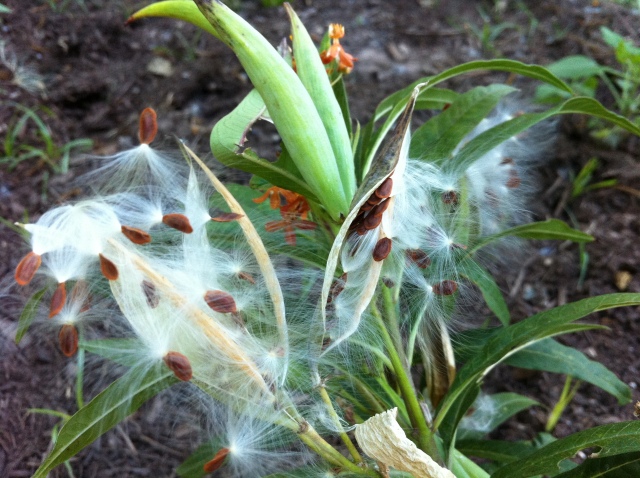The Antelope Horns milkweed we saw on our Texas roadsides in April are boasting robust seedpods now, ripe for the plucking. Asclepias asperula was one of the few wildflowers to dot our highways and wildscapes this spring, a welcome contrarian to the dreary drought and voracious winds that defined the second quarter of 2011. Fortunately, native species like these defy harsh conditions that leave other plants wilting.
We encourage butterfly gardeners to collect these seeds now to be cultivated into Monarch and Queen butterfly host plants. Surplus seeds can be sent to the Bring Back the Monarchs program, a milkweed restoration project organized by Monarch Watch at the University of Kansas at Lawrence.
Monarch Watch, our favorite source for Monarch butterfly info, offers the following tips for collecting milkweed seeds:
- Mature pods are those that are within a day or two of opening. If you squeeze the pods and they don’t open easily, they usually do not contain mature brown seeds. Seeds well into the process of browning and hardening will germinate when planted the next season.
- Pale or white seeds should be not collected.
- Freshly collected pods should be dried in an open area with good air circulation.
- Once the pods are thoroughly dry, the seeds can be separated from the coma, or silk-like ballooning material (sometimes called “fluff”), by hand.
- Separation of seeds can also be accomplished by stripping the seeds and coma from the pods into a paper bag.
- Shake the contents of the bag vigorously to separate the seeds from the coma and then cut a small hole in a corner of the bottom of the bag and shake out the seeds.
- Store dried seeds in a cool, dry place protected from mice and insects – a plastic bag (reclosable) or other container in the refrigerator works well.
Those of us who plant Tropical Milkweed, Asclepias curassavica, in our gardens, can also gather seeds from this nonnative bloomer. Althought technically an interloper, Tropical Milkweed is fine in a garden setting, and provides reliable host and nectaring for Monarchs and others. Check out our milkweed guide for Texas for more information.
One of many fun facts about milkweed is that the silky fluff, or seed threads attached to each seed, are more buoyant than cork. The silk “parachutes” catch the wind and efficiently facilitate milkweed propagation. During World War II, the silk was used instead of down in aviation lifejackets. Those who make quilts have even explored using the silky fiber as batting and more than one of us have wondered how much milkweed silk it would take to stuff a pillow.


I LOVE it that you are encouraging this. I’ve been trying to work with restoring Asclepias in Maine, but we’re stuck with a NOT SO GOOD GOVERNOR now…So I gather seed and spread it and hope for a crop of Monarchs.
I am going to be doing some television in Texas and may be talking about replanting for butterflies. Let’s stay in contact!
All joys,
Sharon Lovejoy Writes from Sunflower House and a Little Green Island
Thank you, Sharon. Would love to connect some time. Keep up the good work in Maine!
What a great project to offer during this time of year. Thank you.
Our winters here in NW Wisconsin seem endlessly dark and this sort of project is just the infusion of faith and hope needed to get us thru!
By the way, does anybody know of any other ardently active Monarch (etc.) friends in my region?
I’m familiar with the existing foundations & the dPlex forum etc. etc.but no individuals within these I know of. I KNOW ‘they’re out there’ but after years of searching still no success. If none exist, I’ve a goal to create an active dialoguing network. I’ve done a lot of legwork & have established interest w/local nurseries, and other community & school etc. groups but need help & feedback. etc.
I live in Eau Claire, WI. 90 miles due east across Minnesota border– Minneapolis & St. Paul. I’ve had better luck corresponding w/Karen Oberhauser at U of MN BUT of course any potential of collaboration for grants etc.present little if any hope of transferring across State lines. And I regret to say our current WI Governor has stripped funding of existing and potential environmentally-focused programs. I AM however not giving up and am researching the Federal initiative for ‘no child left ‘inside’ …at least verbal endorsement has been publicized.
Any suggestions and guidance or brutal truths are welcome.
Thank you for all you do.
Cindy in WI
Thanks for writing, Cindy. Glad you enjoyed the post.
Have you engaged in the Monarch Watch Facebook page? I find it to be a fantastic, active community of Monarch lovers. You might even be able to search the group or post an invite to connect with those in your region. Give it a try.
Good luck with your efforts, and please keep us posted.
Monika